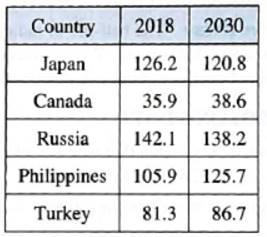
Concept explainers
a.
The exponential growth or decay model for the population of each country.
Explanation of Solution
Given information:
The exponential growth or decay model is given by formula,

The table shows the population (in millions) of five countries in the year 2018 and the projected population (in millions) for the year 2030.
Calculations:
Here the population in Japan has decreased from the year 2018 to 2030. So it is following exponential decay model.
Now,
Now putting the values we get,
Thus the exponential decay model for Japan is
Now for Canada.
Here the population in Canada has increased from the year 2018 to 2030. So it is following exponential growth model.
Now,
Now putting the values we get,
Thus the exponential growth model for Canada is
Now for Russia.
Here the population in Russia has decreased from the year 2018 to 2030. So it is following exponential decay model.
Now,
Now putting the values we get,
Thus the exponential decay model for Russia is
Now for Philippines.
Here the population in Philippines has increased from the year 2018 to 2030. So it is following exponential growth model.
Now,
Now putting the values we get,
Thus the exponential decay growth for Philippines is
Now for Turkey.
Here the population in Turkey has increased from the year 2018 to 2030. So it is following exponential growth model.
Now,
Now putting the values we get,
Thus the exponential growth model for Turkey is
Chapter 3 Solutions
PRECALCULUS W/LIMITS:GRAPH.APPROACH(HS)
- Find the accumulated amount A, if the principal P is invested at an interest rate of r per year for t years. (Round your answer to the nearest cent.) P = $3800, r = 4%, t = 10, compounded semiannually A = $ 5645.60 × Need Help? Read It SUBMIT ANSWER [3.33/6.66 Points] DETAILS MY NOTES REVIOUS ANSWERS ASK YOUR TEACHER TANAPCALC10 5.3.001.EP. PRACTICE ANOTHER Consider the following where the principal P is invested at an interest rate of r per year for t years. P = $3,100, r = 4%, t = 10, compounded semiannually Determine m, the number of conversion periods per year. 2 Find the accumulated amount A (in dollars). (Round your answer to the nearest cent.) A = $ 4604.44arrow_forwardForce with 800 N and 400 N are acting on a machine part at 30° and 60°, respectively with a positive x axis, Draw the diagram representing this situationarrow_forwardI forgot to mention to you to solve question 1 and 2. Can you solve it using all data that given in the pict i given and can you teach me about that.arrow_forward
 Calculus: Early TranscendentalsCalculusISBN:9781285741550Author:James StewartPublisher:Cengage Learning
Calculus: Early TranscendentalsCalculusISBN:9781285741550Author:James StewartPublisher:Cengage Learning Thomas' Calculus (14th Edition)CalculusISBN:9780134438986Author:Joel R. Hass, Christopher E. Heil, Maurice D. WeirPublisher:PEARSON
Thomas' Calculus (14th Edition)CalculusISBN:9780134438986Author:Joel R. Hass, Christopher E. Heil, Maurice D. WeirPublisher:PEARSON Calculus: Early Transcendentals (3rd Edition)CalculusISBN:9780134763644Author:William L. Briggs, Lyle Cochran, Bernard Gillett, Eric SchulzPublisher:PEARSON
Calculus: Early Transcendentals (3rd Edition)CalculusISBN:9780134763644Author:William L. Briggs, Lyle Cochran, Bernard Gillett, Eric SchulzPublisher:PEARSON Calculus: Early TranscendentalsCalculusISBN:9781319050740Author:Jon Rogawski, Colin Adams, Robert FranzosaPublisher:W. H. Freeman
Calculus: Early TranscendentalsCalculusISBN:9781319050740Author:Jon Rogawski, Colin Adams, Robert FranzosaPublisher:W. H. Freeman
 Calculus: Early Transcendental FunctionsCalculusISBN:9781337552516Author:Ron Larson, Bruce H. EdwardsPublisher:Cengage Learning
Calculus: Early Transcendental FunctionsCalculusISBN:9781337552516Author:Ron Larson, Bruce H. EdwardsPublisher:Cengage Learning





